Peer Status Influences In-Group Favoritism in Pain Empathy During Middle Childhood: Evidence from Behavioral and Event-Related Potentials Studies
Abstract
1. Introduction
2. Experiment 1
2.1. Methods
2.1.1. Participants
2.1.2. Design and Material
2.1.3. Procedure
2.2. Results
2.3. Discussion
3. Experiment 2
3.1. Methods
3.1.1. Participants
3.1.2. Design and Material
3.1.3. Procedure
3.1.4. EEG Recording
3.1.5. EEG Preprocessing
3.2. Results
3.2.1. Behavioral Results
3.2.2. ERP Results
- N1 (120–160 ms)
- N2 (220–280 ms)
- P3 (300–400 ms)
- LPP (450–800 ms)
3.3. Discussion
4. General Discussion
5. Conclusions
Author Contributions
Funding
Institutional Review Board Statement
Informed Consent Statement
Data Availability Statement
Acknowledgments
Conflicts of Interest
References
- Decety, J.; Lewis, K.L.; Cowell, J.M. Specific Electrophysiological Components Disentangle Affective Sharing and Empathic Concern in Psychopathy. J. Neurophysiol. 2015, 114, 493–504. [Google Scholar] [CrossRef] [PubMed]
- Danziger, N.; Prkachin, K.M.; Willer, J.-C. Is Pain the Price of Empathy? The Perception of Others’ Pain in Patients with Congenital Insensitivity to Pain. Brain 2006, 129, 2494–2507. [Google Scholar] [CrossRef] [PubMed]
- Singer, T.; Lamm, C. The Social Neuroscience of Empathy. Ann. N. Y. Acad. Sci. 2009, 1156, 81–96. [Google Scholar] [CrossRef] [PubMed]
- Decety, J.; Meyer, M. From Emotion Resonance to Empathic Understanding: A Social Developmental Neuroscience Account. Dev. Psychopathol. 2008, 20, 1053–1080. [Google Scholar] [CrossRef] [PubMed]
- Huang, H.Q.; Su, Y.J. The Development of Empathy Across the Lifespan: A Perspective of Double Processes. Psychological Dev. Educ. 2012, 28, 434–441. [Google Scholar] [CrossRef]
- Tajfel, H. Social Psychology of Intergroup Relations. Annu. Rev. Psychol. 1982, 33, 1–39. [Google Scholar] [CrossRef]
- Ben-Ner, A.; McCall, B.P.; Stephane, M.; Wang, H. Identity and In-Group/out-Group Differentiation in Work and Giving Behaviors: Experimental Evidence. J. Econ. Behav. Organ. 2009, 72, 153–170. [Google Scholar] [CrossRef]
- Krautheim, J.T.; Dannlowski, U.; Steines, M.; Neziroğlu, G.; Acosta, H.; Sommer, J.; Straube, B.; Kircher, T. Intergroup Empathy: Enhanced Neural Resonance for Ingroup Facial Emotion in a Shared Neural Production-Perception Network. Neuroimage 2019, 194, 182–190. [Google Scholar] [CrossRef] [PubMed]
- Avenanti, A.; Sirigu, A.; Aglioti, S.M. Racial Bias Reduces Empathic Sensorimotor Resonance with Other-Race Pain. Curr. Biol. 2010, 20, 1018–1022. [Google Scholar] [CrossRef] [PubMed]
- Forgiarini, M.; Gallucci, M.; Maravita, A. Racism and the Empathy for Pain on Our Skin. Front. Psychol. 2011, 2, 108. [Google Scholar] [CrossRef]
- Sheng, F.; Du, N.; Han, S. Degraded Perceptual and Affective Processing of Racial Out-Groups: An Electrophysiological Approach. Soc. Neurosci. 2017, 12, 479–487. [Google Scholar] [CrossRef]
- Xu, X.; Zuo, X.; Wang, X.; Han, S. Do You Feel My Pain? Racial Group Membership Modulates Empathic Neural Responses. J. Neurosci. 2009, 29, 8525–8529. [Google Scholar] [CrossRef] [PubMed]
- Cao, Y.; Contreras-Huerta, L.S.; McFadyen, J.; Cunnington, R. Racial Bias in Neural Response to Others’ Pain Is Reduced with Other-Race Contact. Cortex 2015, 70, 68–78. [Google Scholar] [CrossRef]
- Cheng, Y.; Chen, C.; Lin, C.-P.; Chou, K.-H.; Decety, J. Love Hurts: An fMRI Study. Neuroimage 2010, 51, 923–929. [Google Scholar] [CrossRef] [PubMed]
- Hein, G.; Silani, G.; Preuschoff, K.; Batson, C.D.; Singer, T. Neural Responses to Ingroup and Outgroup Members’ Suffering Predict Individual Differences in Costly Helping. Neuron 2010, 68, 149–160. [Google Scholar] [CrossRef]
- Saarinen, A.; Jääskeläinen, I.P.; Harjunen, V.; Keltikangas-Järvinen, L.; Jasinskaja-Lahti, I.; Ravaja, N. Neural Basis of In-Group Bias and Prejudices: A Systematic Meta-Analysis. Neurosci. Biobehav. Rev. 2021, 131, 1214–1227. [Google Scholar] [CrossRef] [PubMed]
- Decety, J.; Yang, C.-Y.; Cheng, Y. Physicians Down-Regulate Their Pain Empathy Response: An Event-Related Brain Potential Study. Neuroimage 2010, 50, 1676–1682. [Google Scholar] [CrossRef]
- Decety, J. The Neural Pathways, Development and Functions of Empathy. Curr. Opin. Behav. Sci. 2015, 3, 1–6. [Google Scholar] [CrossRef]
- Cheng, Y.; Hung, A.-Y.; Decety, J. Dissociation between Affective Sharing and Emotion Understanding in Juvenile Psychopaths. Dev. Psychopathol. 2012, 24, 623–636. [Google Scholar] [CrossRef]
- Sheng, F.; Han, S. Manipulations of Cognitive Strategies and Intergroup Relationships Reduce the Racial Bias in Empathic Neural Responses. Neuroimage 2012, 61, 786–797. [Google Scholar] [CrossRef] [PubMed]
- Sessa, P.; Meconi, F.; Castelli, L.; Dell’Acqua, R. Taking One’s Time in Feeling Other-Race Pain: An Event-Related Potential Investigation on the Time-Course of Cross-Racial Empathy. Soc. Cogn. Affect. Neurosci. 2014, 9, 454–463. [Google Scholar] [CrossRef] [PubMed]
- Fabi, S.; Leuthold, H. Empathy for Pain Influences Perceptual and Motor Processing: Evidence from Response Force, ERPs, and EEG Oscillations. Soc. Neurosci. 2017, 12, 701–716. [Google Scholar] [CrossRef] [PubMed]
- Song, J.; Guo, F.B.; Zhang, Z.; Yuan, S.; Jin, H.; Wang, Y.W. Interpersonal distance influences on pain empathy: Friends priming effect. Acta Psychol. Sin. 2016, 48, 833–844. [Google Scholar] [CrossRef]
- Huang, W.J. Cognitive Load and Interpersonal Distance Influences on Pain Empathy and Their Neural Underpinnings. Master’s Thesis, Guangxi Normal University, Nanning, China, 2019. [Google Scholar]
- Otten, S. The Minimal Group Paradigm and Its Maximal Impact in Research on Social Categorization. Curr. Opin. Psychol. 2016, 11, 85–89. [Google Scholar] [CrossRef]
- Kelly, D.J.; Quinn, P.C.; Slater, A.M.; Lee, K.; Gibson, A.; Smith, M.; Ge, L.; Pascalis, O. Three-month-olds, but not newborns, prefer own-race faces. Dev. Sci. 2005, 8, F31. [Google Scholar] [CrossRef] [PubMed]
- Kinzler, K.D.; Dupoux, E.; Spelke, E.S. The Native Language of Social Cognition. Proc. Natl. Acad. Sci. USA 2007, 104, 12577–12580. [Google Scholar] [CrossRef] [PubMed]
- Mahajan, N.; Wynn, K. Origins of “Us” versus “Them”: Prelinguistic Infants Prefer Similar Others. Cognition 2012, 124, 227–233. [Google Scholar] [CrossRef] [PubMed]
- Griffiths, J.A.; Nesdale, D. In-Group and out-Group Attitudes of Ethnic Majority and Minority Children. Int. J. Intercult. Relat. 2006, 30, 735–749. [Google Scholar] [CrossRef]
- Shutts, K.; Kinzler, K.D.; McKee, C.B.; Spelke, E.S. Social information guides infants’ selection of foods. J. Cogn. Dev. Off. J. Cogn. Dev. Soc. 2009, 10, 1. [Google Scholar] [CrossRef]
- Aboud, F.E. A Social-Cognitive Developmental Theory of Prejudice. In Handbook of Race, Racism, and the Developing Child; John Wiley & Sons, Inc.: Hoboken, NJ, USA, 2008; pp. 55–71. [Google Scholar]
- Jordan, J.J.; McAuliffe, K.; Warneken, F. Development of In-Group Favoritism in Children’s Third-Party Punishment of Selfishness. Proc. Natl. Acad. Sci. USA 2014, 111, 12710–12715. [Google Scholar] [CrossRef]
- Weng, Q.Q. The Influence of In-Group Favoritism on Primary School Students’ Moral Judgement. Master’s Thesis, Fujian Normal University, Fuzhou, China, 2020. [Google Scholar]
- Susskind, J.E.; Hodges, C. Decoupling Children’s Gender-Based in-Group Positivity from out-Group Negativity. Sex Roles J. Res. 2007, 56, 707–716. [Google Scholar] [CrossRef]
- Gonzalez-Gadea, M.L.; Santamaría-García, H.; Aragón, I.; Santamaría-García, J.; Herrera, E.; Ibáñez, A.; Sigman, M. Transgression of Cooperative Helping Norms Outweighs Children’s Intergroup Bias. Cogn. Dev. 2020, 54, 100878. [Google Scholar] [CrossRef]
- Shao, Y.; Kang, S.; Lu, Q.; Zhang, C.; Li, R. How Peer Relationships Affect Academic Achievement among Junior High School Students: The Chain Mediating Roles of Learning Motivation and Learning Engagement. BMC Psychol. 2024, 12, 278. [Google Scholar] [CrossRef]
- Coie, J.D.; Dodge, K.A.; Coppotelli, H. Dimensions and Types of Social Status: A Cross-Age Perspective. Dev. Psychol. 1982, 18, 557–570. [Google Scholar] [CrossRef]
- Williams, B.T.R.; Gilmour, J.D. Sociometry and Peer Relationships. Child. Psychol. Psychiatry Allied Discip. 1994, 35, 997–1013. [Google Scholar] [CrossRef] [PubMed]
- Langford, D.J.; Crager, S.E.; Shehzad, Z.; Smith, S.B.; Sotocinal, S.G.; Levenstadt, J.S.; Chanda, M.L.; Levitin, D.J.; Mogil, J.S. Social Modulation of Pain as Evidence for Empathy in Mice. Science 2006, 312, 1967–1970. [Google Scholar] [CrossRef]
- Campbell, M.W.; de Waal, F.B.M. Ingroup-Outgroup Bias in Contagious Yawning by Chimpanzees Supports Link to Empathy. PLoS ONE 2011, 6, e18283. [Google Scholar] [CrossRef] [PubMed]
- Pang, L.J. A Comparative Study of Psychological Characteristics of Different Types of Preschool Children’s Peer Interaction. Acta Psychol. Sin. 1993, 25, 84–91. [Google Scholar]
- Coie, J.D.; Dodge, K.A.; Kupersmidt, J.B. Peer Group Behavior and Social Status. In Peer Rejection in Childhood; Cambridge Studies in Social and Emotional Development; Cambridge University Press: New York, NY, USA, 1990; pp. 17–59. [Google Scholar]
- Newcomb, A.F.; Bukowski, W.M.; Pattee, L. Children’s Peer Relations: A Meta-Analytic Review of Popular, Rejected, Neglected, Controversial, and Average Sociometric Status. Psychol. Bull. 1993, 113, 99–128. [Google Scholar] [CrossRef]
- Faul, F.; Erdfelder, E.; Lang, A.-G.; Buchner, A. G*Power 3: A Flexible Statistical Power Analysis Program for the Social, Behavioral, and Biomedical Sciences. Behav. Res. Methods 2007, 39, 175–191. [Google Scholar] [CrossRef] [PubMed]
- Wang, H. A Study on the Relationship Between Altruistic Behavior and Academic Achievement of Primary School Students: The Mediating Role of Interpersonal Relationships. Master’s Thesis, Shandong Normal University, Jinan, China, 2017. [Google Scholar]
- Sun, X.; Li, X.; Jia, L.; Zhang, Q. The Relative Uniqueness of Personal Names: Evidences from the RSVP. J. Psychol. Sci. 2013, 36, 72–77. [Google Scholar]
- Lei, Y.R. The Effect of Empathy for Pain on Attentional Bias of Negative Emotion in College Students. Master’s Thesis, Tianjin Normal University, Tianjin, China, 2020. [Google Scholar]
- Wong, D.L.; Baker, C.M. Pain in Children: Comparison of Assessment Scales. Pediatr. Nurs. 1988, 14, 9–17. [Google Scholar]
- Kim, H.; Luo, J.; Chu, S.; Cannard, C.; Hoffmann, S.; Miyakoshi, M. ICA’s Bug: How Ghost ICs Emerge from Effective Rank Deficiency Caused by EEG Electrode Interpolation and Incorrect Re-Referencing. Front. Signal Process. 2023, 3, 1064138. [Google Scholar] [CrossRef]
- Delorme, A.; Makeig, S. EEGLAB: An Open Source Toolbox for Analysis of Single-Trial EEG Dynamics Including Independent Component Analysis. J. Neurosci. Methods 2004, 134, 9–21. [Google Scholar] [CrossRef] [PubMed]
- Rubin, K.H.; Bukowski, W.M.; Parker, J.G. Peer Interactions, Relationships, and Groups. In Handbook of Child Psychology; Damon, W., Lerner, R.M., Eds.; John Wiley & Sons, Inc.: Hoboken, NJ, USA, 2007; p. chpsy0310. [Google Scholar] [CrossRef]
- Cillessen, A.H.N. Sociometric Methods. In Handbook of Peer Interactions, Relationships, and Groups; Social, Emotional, and Personality Development in Context; The Guilford Press: New York, NY, USA, 2009; pp. 82–99. [Google Scholar]
- Cillessen, A.H.N.; Rose, A.J. Understanding Popularity in the Peer System. Curr. Dir. Psychol. Sci. 2005, 14, 102–105. [Google Scholar] [CrossRef]
- Wilt, F.; Van der Veen, C.; van Kruistum, C.; Oers, B. Popular, Rejected, Neglected, Controversial or Average: Do Young Children of Different Sociometric Groups Differ in Their Level of Oral Communicative Competence? Soc. Dev. 2018, 27, 793–807. [Google Scholar] [CrossRef]
- Zhao, Q.; Ren, Q.; Sun, Y.; Wan, L.; Hu, L. Impact Factors of Empathy in Mainland Chinese Youth. Front. Psychol. 2020, 11, 688. [Google Scholar] [CrossRef] [PubMed]
- Fusaro, M.; Tieri, G.; Aglioti, S.M. Seeing Pain and Pleasure on Self and Others: Behavioral and Psychophysiological Reactivity in Immersive Virtual Reality. J. Neurophysiol. 2016, 116, 2656–2662. [Google Scholar] [CrossRef]
- Nazarewicz, J.; Verdejo-Garcia, A.; Giummarra, M.J. Sympathetic Pain? A Role of Poor Parasympathetic Nervous System Engagement in Vicarious Pain States. Psychophysiology 2015, 52, 1529–1537. [Google Scholar] [CrossRef]
- Cui, F.; Zhu, X.; Luo, Y. Social Contexts Modulate Neural Responses in the Processing of Others’ Pain: An Event-Related Potential Study. Cogn. Affect. Behav. Neurosci. 2017, 17, 850–857. [Google Scholar] [CrossRef] [PubMed]
- Fan, Y.; Han, S. Temporal Dynamic of Neural Mechanisms Involved in Empathy for Pain: An Event-Related Brain Potential Study. Neuropsychologia 2008, 46, 160–173. [Google Scholar] [CrossRef]
- Mathur, V.A.; Harada, T.; Lipke, T.; Chiao, J.Y. Neural Basis of Extraordinary Empathy and Altruistic Motivation. Neuroimage 2010, 51, 1468–1475. [Google Scholar] [CrossRef]
- Coll, M.-P. Meta-Analysis of ERP Investigations of Pain Empathy Underlines Methodological Issues in ERP Research. Soc. Cogn. Affect. Neurosci. 2018, 13, 1003–1017. [Google Scholar] [CrossRef] [PubMed]
- Cheng, Y.; Chen, C.; Decety, J. An EEG/ERP Investigation of the Development of Empathy in Early and Middle Childhood. Dev. Cogn. Neurosci. 2014, 10, 160–169. [Google Scholar] [CrossRef] [PubMed]
- Batty, M.; Taylor, M.J. The Development of Emotional Face Processing during Childhood. Dev. Sci. 2006, 9, 207–220. [Google Scholar] [CrossRef] [PubMed]
- Cordón, I.M.; Georgieff, M.K.; Nelson, C.A. Neural Correlates of Emotion Processing in Typically Developing Children and Children of Diabetic Mothers. Dev. Neuropsychol. 2009, 34, 683–700. [Google Scholar] [CrossRef] [PubMed][Green Version]
- Dawson, G.; Webb, S.J.; Carver, L.; Panagiotides, H.; McPartland, J. Young Children with Autism Show Atypical Brain Responses to Fearful versus Neutral Facial Expressions of Emotion. Dev. Sci. 2004, 7, 340–359. [Google Scholar] [CrossRef]
- Dennis, T.A.; Hajcak, G. The Late Positive Potential: A Neurophysiological Marker for Emotion Regulation in Children. J. Child. Psychol. Psychiatry 2009, 50, 1373–1383. [Google Scholar] [CrossRef]
- Hajcak, G.; MacNamara, A.; Olvet, D.M. Event-Related Potentials, Emotion, and Emotion Regulation: An Integrative Review. Dev. Neuropsychol. 2010, 35, 129–155. [Google Scholar] [CrossRef]
- Kujawa, A.; Hajcak, G.; Torpey, D.; Kim, J.; Klein, D.N. Electrocortical Reactivity to Emotional Faces in Young Children and Associations with Maternal and Paternal Depression. J. Child. Psychol. Psychiatry 2012, 53, 207–215. [Google Scholar] [CrossRef]
- Wessing, I.; Fürniss, T.; Zwitserlood, P.; Dobel, C.; Junghöfer, M. Early Emotion Discrimination in 8- to 10-Year-Old Children: Magnetoencephalographic Correlates. Biol. Psychol. 2011, 88, 161–169. [Google Scholar] [CrossRef] [PubMed]
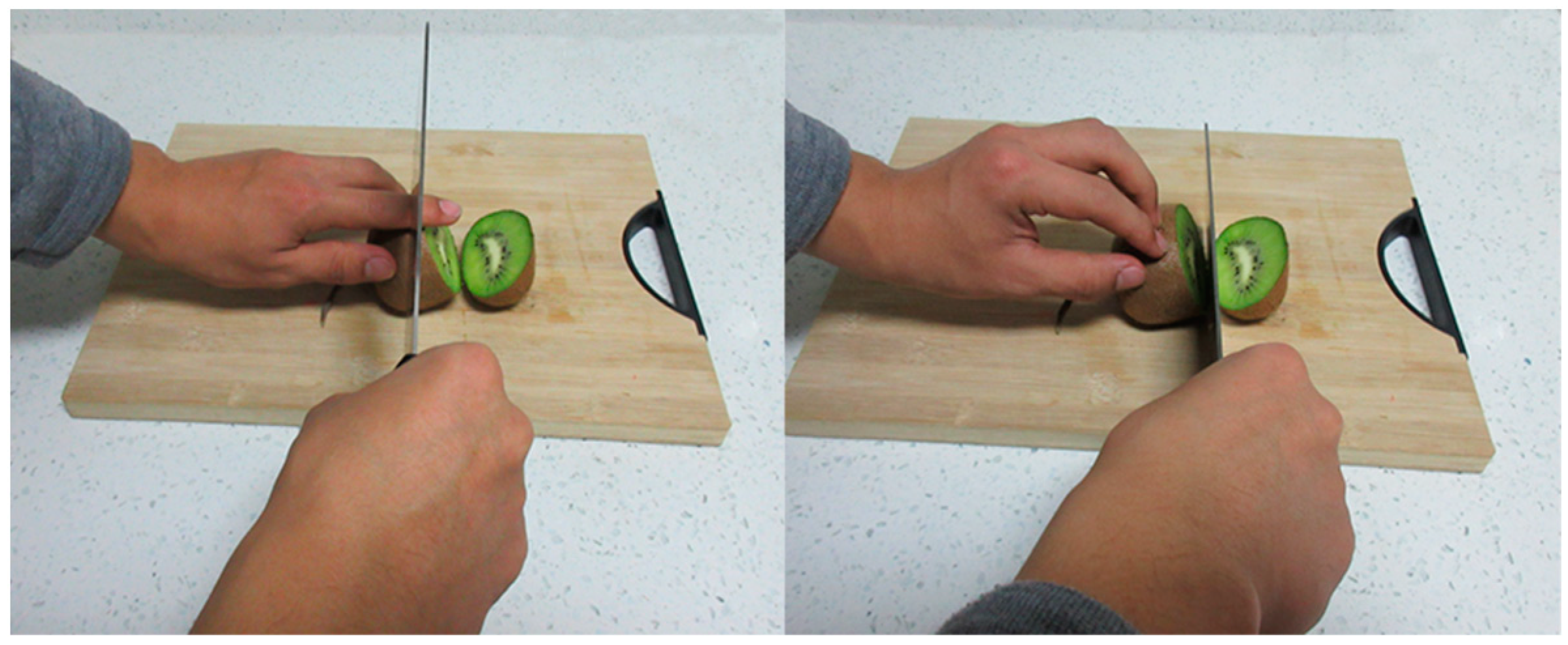

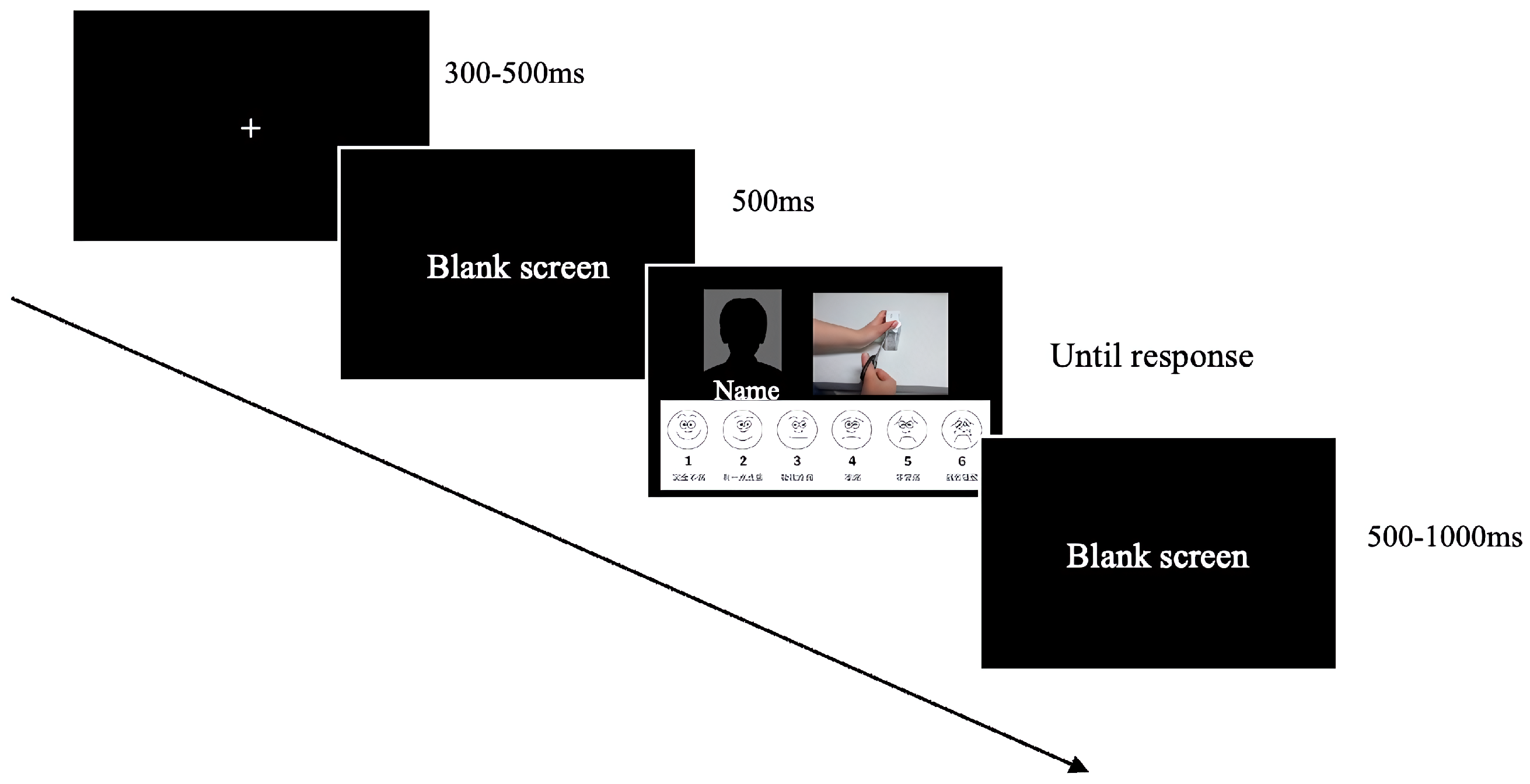
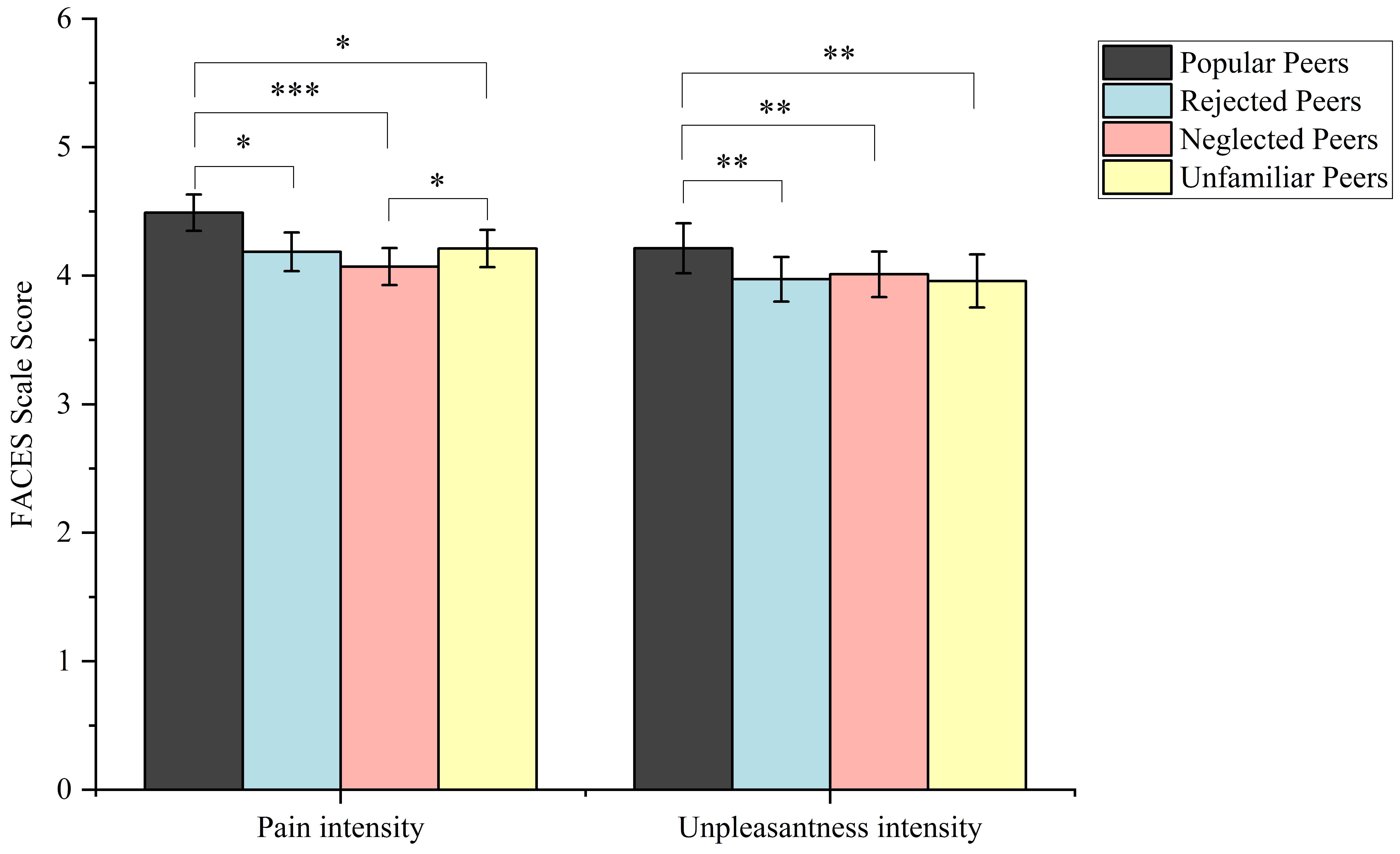
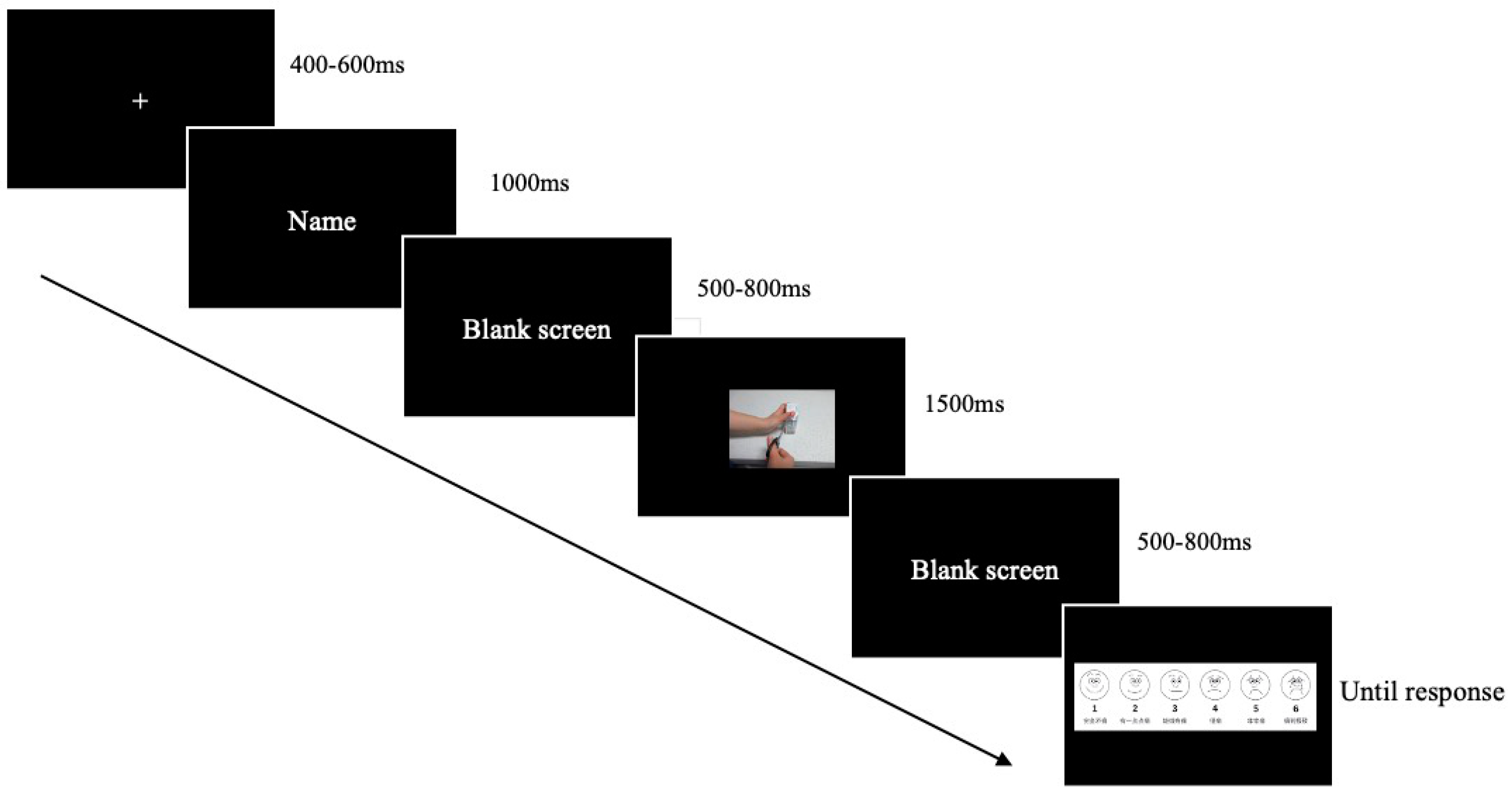
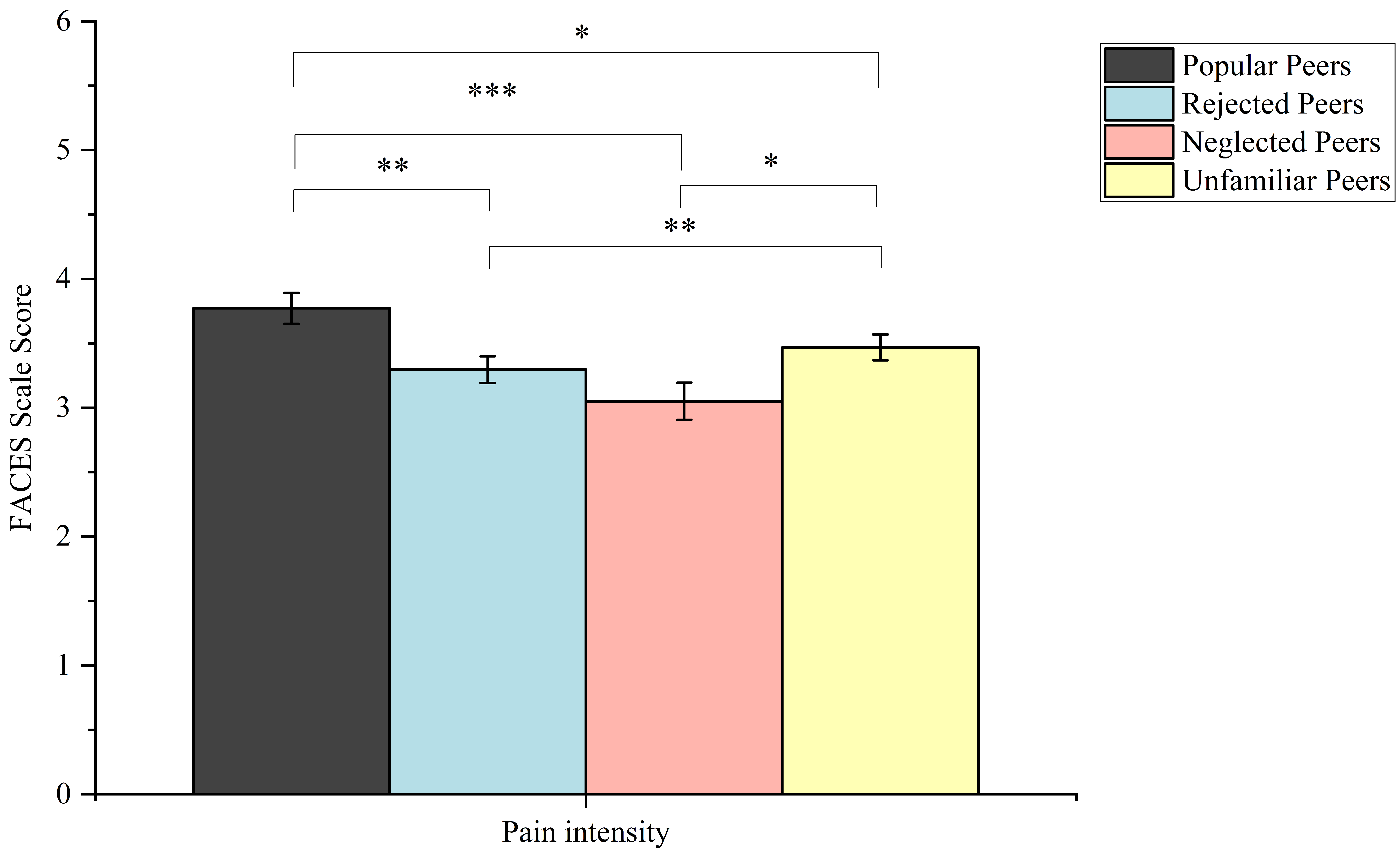

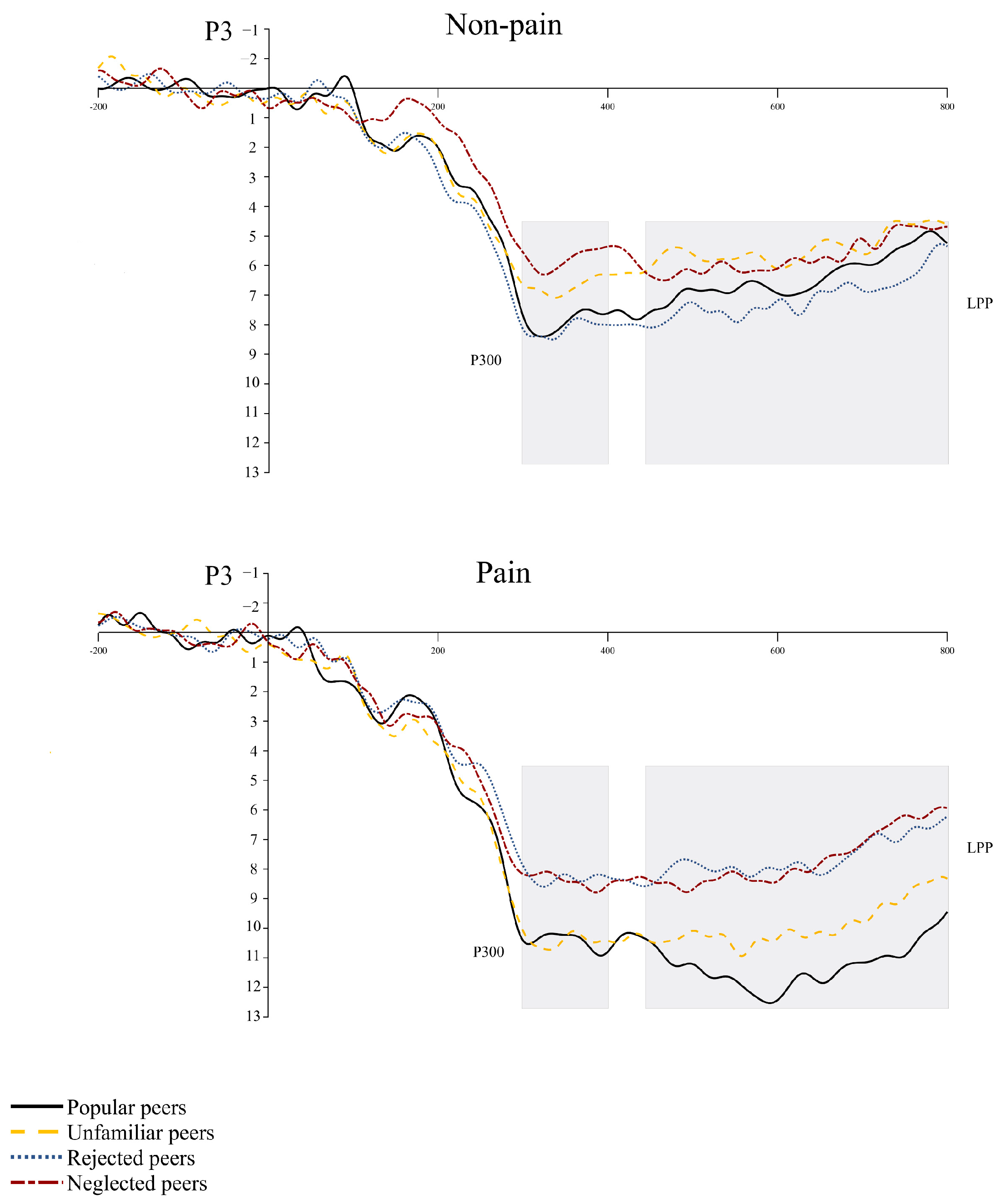
Disclaimer/Publisher’s Note: The statements, opinions and data contained in all publications are solely those of the individual author(s) and contributor(s) and not of MDPI and/or the editor(s). MDPI and/or the editor(s) disclaim responsibility for any injury to people or property resulting from any ideas, methods, instructions or products referred to in the content. |
© 2024 by the authors. Licensee MDPI, Basel, Switzerland. This article is an open access article distributed under the terms and conditions of the Creative Commons Attribution (CC BY) license (https://creativecommons.org/licenses/by/4.0/).
Share and Cite
Chen, Y.; Liang, J.; Han, G.; Yang, X.; Song, J. Peer Status Influences In-Group Favoritism in Pain Empathy During Middle Childhood: Evidence from Behavioral and Event-Related Potentials Studies. Brain Sci. 2024, 14, 1262. https://doi.org/10.3390/brainsci14121262
Chen Y, Liang J, Han G, Yang X, Song J. Peer Status Influences In-Group Favoritism in Pain Empathy During Middle Childhood: Evidence from Behavioral and Event-Related Potentials Studies. Brain Sciences. 2024; 14(12):1262. https://doi.org/10.3390/brainsci14121262
Chicago/Turabian StyleChen, Yiyue, Jingyuan Liang, Gaoxin Han, Xue Yang, and Juan Song. 2024. "Peer Status Influences In-Group Favoritism in Pain Empathy During Middle Childhood: Evidence from Behavioral and Event-Related Potentials Studies" Brain Sciences 14, no. 12: 1262. https://doi.org/10.3390/brainsci14121262
APA StyleChen, Y., Liang, J., Han, G., Yang, X., & Song, J. (2024). Peer Status Influences In-Group Favoritism in Pain Empathy During Middle Childhood: Evidence from Behavioral and Event-Related Potentials Studies. Brain Sciences, 14(12), 1262. https://doi.org/10.3390/brainsci14121262





